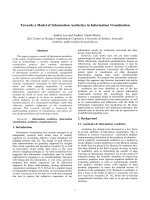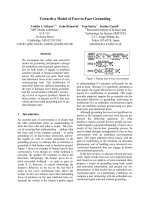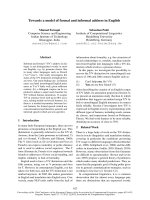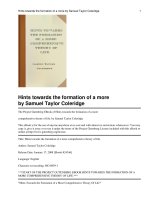Towards a sociology of photography (Pierre Bourdieu)
Bạn đang xem bản rút gọn của tài liệu. Xem và tải ngay bản đầy đủ của tài liệu tại đây (678.72 KB, 5 trang )
Towards a Sociology of Photography'
Pierre Bourdieu
Is it possible and necessary for the practice of photography
and the meaning of the photographic image to provide material
for sociology? Weberian thought has lent credence to the idea
that the value of an object of research is dependent on the
interests of the researcher. This disenchanting relativism at
least allows the illusion of an element of choice in the encounter
between researchers and their objects. In fact, the most rudimentary techniques of the sociology of knowledge would show
that in every society, and throughout history, there exists a
hierarchy of legitimate objects of study. Inheriting a tradition
of political philosophy and social action, must sociology abandon
the anthropological project to other sciences and, taking as its
exclusive object the study of the most general and abstract
conditions of experience and action, can it reject as meaningless
types of behavior whose historical importance is not immediately apparent?
But it takes more than a sociology of sociology to show that
all too often, beneath grand ambitions, it conceals a massive
renunciation. The same fundamental intention is probably
expressed by banishing from scientific study certain objects
held to be meaningless, and excluding from it, under the guise
of objectivity, the experience of those who work in it and those
who are its object.
Efforts to reintroduce the experience of agents into an
objective account are too easily discredited by identifying this
methodological requirement with the question-begging with
which certain defenders of the sacred rights of subjectivity
attack the social sciences, without recognizing that the most
significant advances in those sciences have been made thanks
to the methodological decision to 'treat social facts as things'.
Visual Anthropology Review
They are also too easily discredited because this regulatory idea
is condemned to appear an inaccessible ideal: in fact, one can
never reach the infinitely receding point which might allow
sociologists to encompass, within the unity of a total apprehension, the objective relationships which they can only comprehend at the cost of an abstract construction and the experience
in which these relationships are rooted and from which they
draw their meaning.
The subjectivist intuitionism that seeks a meaning in the
immediacy of lived experience would not be worth attending to
for a moment if it did not serve as an excuse for objectivism,
which limits itself to establishing regular relationships and
testing their statistical significance without deciphering their
meaning, and which remains an abstract and formal nominalism as far as it is not seen as a necessary but only a purely
temporary moment of the scientific process. If it is true that this
detour via the establishment of statistical regularities and formalization is the price which must be paid if one wishes to break
with naive familiarity and the illusions of immediate understanding, it is also the case that the properly anthropological
project of reappropriating reified meanings would be negated
by the reification of the reappropriated meanings in the opacity
of abstraction.
By its very existence, sociology presupposes the overcoming of the false opposition arbitrarily erected by subjectivists
and objectivists. Sociology is possible as an objective science
because of the existence of external relationships which are
necessary and independent of individual wills, and, perhaps,
unconscious (in the sense that they are not revealed by simple
reflection), and which can only be grasped by the indirect route
Volume 7 Number 1
Spring 1991
129
of observation and objective experimentation; in other words,
because subjects are not in possession of the meaning of the
whole of their behavior as immediate conscious data, and
because their actions always encompass more meanings than
they know or wish, sociology cannot be a purely introspective
science attaining absolute certainty simply by turning to subjective experience, and, by the same token, it can be an objective
science of the objective (and the subjective), i.e. an experimental
science, experimentation being, in the words of Claude Bernard,
'the only mediator between the objective and the subjective',
Claude Bernard continues:
The experimenter who is faced with natural phenomena is like a spectator watching silent scenes. In a
sense he is nature's examining judge; only, instead of
being up against those who seek to deceive him with
lying testimonies or false witnesses, he is dealing with
natural phenomena which are, as far as he is concerned,
characters whose language and customs are unknown
to him, who live in circumstances which are unknown
to him and yet whose intentions he wishes to know. To
this end he employs all the means within his power.
He observes their actions, their development, their
manifestations, and he seeks to untangle their causes
by using various tests, called experiments. He uses all
imaginable artifices and, as is commonly said, often
tells lies to know the truth, and attributes his own ideas
to nature. He makes certain presuppositions about the
causes of the actions that pass before him, and, in order
to know if the hypothesis at the basis of his interpretation is correct, he sets about bringing to light certain
facts which, in the logical order of things, may confirm
or negate the idea that he has conceived. (1984:52)
This description of the procedures of experimenters faced
with the natural world as ethnologists are faced with societies
whose culture they do not know is also broadly true of sociological research. Whetherthey attempt to grasp their'intentions'
(in the sense meant by Claude Bernard, i.e. their objective
intentions) via objective indicators, or whether, telling lies to
know the truth, they attempt, using indirect questions, to attain
the answers to the questions they are asking themselves and
which the subjects, having been led to err rather than to deceive,
can only answer unawares (and then only indirectly); or even if
they can decipher the meaning included within the regularities
provided by statistics in their raw state, sociologists work to
grasp an objectified meaning, the product of the objectification
of subjectivity which is never directly given either to those who
are involved in the practice or to the outside observer.
But, unlike natural science, a total anthropology cannot
keep to a construction of objective relationships, because the
experience of meaning is part of the total meaning of experience: the sociology least suspected of subjectivism relies on
intermediate concepts and concepts which mediate between the
subjective and the objective, such as alienation, attitude or
ethos. The task of this sociology is to construct the system of
relationships which will encompass both the objective meaning
of organized actions according to measurable regularities and
the particular relationships that subjects have to the objective
conditions of their existence and to the objective meaning of
their behavior, the meaning which possesses them because they
are dispossessed of it.
In other words, the description of objectified subjectivity
refers to the description of the internalization of objectivity.
The three moments of the scientific process are therefore
inseparable: immediate lived experience, understood through
expressions which mask objective meaning as much as they
reveal it, refers to the analysis of objective meanings and the
social conditions which make those meanings possible, an
analysis which requires the construction of the relationship
between the agents and the objective meaning of their actions.
One example will suffice to show that this is not questionbegging but rather a demand for a method with a theoretical
basis. Statistics can objectively establish the system of lifechances objectively attached to particular social categories,
whether these are the chances of attaining permanent employment in the case of an unqualified and uneducated Algerian subproletarian, or the chances of entering a faculty of medicine or
law in the case of a manual worker's daughter. A statistic such
as this remains abstract and almost unreal unless one knows
how this objective truth (never perceived directly as such) is
actualized in the practice of the subjects: even when, at first
glance, action and discourse appear to refute the future objectively inscribed in the objective conditions, they only reveal
their entire significance if one observes that they imply a
practical reference to this future. Thus, sub-proletarians may
have magical and fantastic hopes which only apparently contradict the objective truth of their conditions, since they characterize the aims for the future appropriate to those without an
objective future; similarly, the manual worker's or peasant's
daughter, of whom statistics reveal that she has had to pay for
her attainment of higher education by being relegated to the arts
faculty, can carry out her studies as the fulfillment of a fully
positive 'vocation', although herpractices betray, especially by
the mode in which they are carried out, a practical reference to
the objective truth of her condition and her future.2 The class
Pierre Bourdieu is Professor of Sociology at the College de France and Director of the Center for European Sociology at the Ecole
des Hautes Etudes en Sciences Sociales. His recent publications include Distinction: A Social Critique of the Judgement of Taste
(1984 (1979) Cambridge, Mass.: Harvard University Press) and The Political Ontology of Martin Heidegger (1991 (1988)
Cambridge: Polity Press).
130
Spring 1991
Volume 7 Number 1
Visual Anthropology Review
habitus is nothing but this experience (in its most usual sense)
which immediately reveals a hope or an ambition as reasonable
or unreasonable, a particular commodity as accessible or inaccessible, a particular action as suitable or unsuitable. In short,
a total anthropology would have to culminate in an analysis of
the process by which objectivity becomes rooted in subjective
experience: it must overcome it by encompassing the moment
of objectivism and base it in a theory of the externalization of
interiority and the internalization of exteriority.
Everything therefore takes place as if the shadow cast by
objective conditions always extended to consciousness: the
infraconscious reference to objective determinisms which influence practice and always owe some of their effectiveness to
the complicity of a subjectivity that bears their stamp and is
determined by the hold they exert. Thus the science of objective
regularities remains abstract as long as it does not encompass
the science of the process of the internalization of objectivity
leading to the constitution of those systems of unconscious and
durable dispositions that are the class habitus and the ethos: as
long as it does not endeavor to establish how the myriad 'small
perceptions' of everyday life and the convergent and repeated
sanctions of the economic and social universe imperceptibly
constitute, from childhood and throughout one's life, by means
of constant reminders, this 'unconscious' which becomes
paradoxically defined as a practical reference to objective
conditions.
One might say of photography what Hegel said of philosophy: "No other art or science is subjected to this last degree
of scorn, to the supposition that we are masters of it without
ado" (Preface, Principles of the Philosophy of Right). Unlike
more demanding cultural activities such as drawing, painting or
playing a musical instrument, unlike even going to museums or
concerts, photography presupposes neither academically
communicated culture, nor the apprenticeships and the 'profession' which confer their value on the cultural consumptions
and practices ordinarily held to be the most noble, by withholding
them from the man in the street.3
Nothing is more directly opposed to the ordinary image of
artistic creation than the activity of the amateur photographer,
who often demands that his camera should perform the greatest
possible number of operations for him, identifying the degree of
sophistication of the apparatus that he uses with its degree of
automatism.4 However, even when the production of the
picture is entirely delivered over to the automatism of the
camera, the taking of the picture is still a choice involving
aesthetic and ethical values: if, in the abstract, the nature and
development of photographic technology tend to make everything objectively 'photographable', it is still true that, from
among the theoretically infinite number of photographs which
are technically possible, each group chooses a finite and well
defined range of subjects, genres and compositions. In
Visual Anthropology Review
Nietzsche's words, "The artist chooses his subjects. It is his
way of praising"( 1974:245). Because it is a 'choice that
praises', because it strives to capture, that is, to solemnize and
to immortalize, photography can not be delivered over to the
randomness of the individual imagination and, via the mediation of the ethos, the internalization of objective and common
regularities, the group places this practice under its collective
rule, so that the most trivial photograph expresses, apart from
the explicit intentions of the photographer, the system of
schemes of perception, thought and appreciation common to a
whole group.
In other words, the range of that which suggests itself as
really photographable for a given social class (that is, the range
of 'takeable' photographs or photographs 'to be taken', as
opposed to the universe of realities which are objectively
photographable given the technical possibilities of the camera)
is defined by implicit models which may be understood via
photographic practice and its product, because they objectively
determine the meaning which a group confers upon the photographic act as the ontological choice of an object which is
perceived as worthy of being photographed, which is captured,
stored, communicated, shown and admired. The norms which
organize the photographic valuation of the world in terms of the
opposition between that which is photographable and that
which is not are indissociable from the implicit system of values
maintained by a class, profession or artistic coterie, of which the
photographic aesthetic must always be one aspect even if it
desperately claims autonomy. Adequately understanding a
photograph, whether it is taken by a Corsican peasant,a petitbourgeois from Bologna or a Parisian professional, means not
only recovering the meanings which it proclaims, that is, to a
certain extent, the explicit intentions of the photographer, it also
means deciphering the surplus of meaning which it betrays by
being a part of the symbolism of an age, a class or an artistic
group.
Unlike fully consecrated artistic activities, such as painting
or music, photographic practice is considered accessible to
everyone, from both the technical and the economic viewpoints,
and those involved in it do not feel they are being measured
against an explicit and codified system defining legitimate
practice in terms of its objects, its occasions and its modalities;
hence the analysis of the subjective or objective meaning that
subjects confer on photography as a practice or as a cultural
work appears as a privileged means of apprehending, in their
most authentic expression, the aesthetics (and ethics) of different
groups or classes and particularly the popular 'aesthetic' which
can, exceptionally, be manifested in it.
In fact, while everything would lead one to expect that this
activity, which has no traditions and makes no demands, would
be delivered over to the anarchy of individual improvisation, it
appears that there is nothing more regulated and conventional
Volume 7 Number 1
Spring 1991
131
than photographic practice and amateur photographs: in the
occasions which give rise to photography, such as the objects,
places and people photographed or the very composition of the
pictures, everything seems to obey implicit canons which are
very generally imposed and which informed amateurs or aesthetes notice as such, but only to denounce them as examples of
poor taste or technical clumsiness. If, in these stilted, posed,
rigid, contrived photographs, taken in accordance with the rules
of a social etiquette which produces photographs of family
celebrations and holiday 'souvenirs', we have been unable to
recognize the body of implicit or explicit rules which define
these aesthetics, it is probably because we have not suspended
an overly limited (and socially conditioned) definition of cultural legitimacy. The most banal tasks always include actions
which owe nothing to the pure and simple quest for efficiency,
and the actions most directly geared towards practical ends may
elicit aesthetic judgements, inasmuch as the means of attaining
the desired ends can always be the objectof a specific valuation:
there are beautiful ways of ploughing or trimming a hedge, just
as there are beautiful mathematical solutions or beautiful rugby
manoeuvres. Thus, most of society can be excluded from the
universe of legitimate culture without being excluded from the
universe of aesthetics.
Even when they do not obey the specific logic of an
autonomous aesthetic, aesthetic judgements and behavior are
organized in a way that is no less systematic but which starts out
from a completely different principle, since the aesthetic is only
one aspect of the system of implicit values, the ethos, associated
with membership of a class. The feature common to all the
popular arts is their subordination of artistic activity to socially
regulated functions while the elaboration of 'pure' forms,
generally considered the most noble, presupposes the disappearance of all functional characteristics and all reference to
practical or ethical goals. Aesthetes who attempt to liberate
photographic practice from the social functions to which the
great majority subordinates them, namely and principally the
recording and compilation of the 'souvenirs' of objects, people
or events socially designated as important, are seeking to make
photography undergo a transformation analogous to that which
affected popular dances, the bourree, sarabande, allemande or
courante, when they were integrated into the scholarly form of
the suite.5
Having constituted photography as an object of sociological study, we first had to establish how each group or class
regulates and organizes the individual practice by conferring
upon it functions attuned to its own interests; but we could not
take as our direct object particular individuals and their relationship to photography as a practice or an object for consumption, without risking falling into abstraction. Only the
methodological decision to make a study based primarily on
'real' groups6 was to allow us to perceive (or prevent us from
forgetting) that the meaning and function conferred upon
132
Spring 1991
Volume 7 Number 1
photography are directly related to the structure of the group, to
the extent of its differentiation and particularly to its position
within the social structure. Thus the relationship of the peasant
to photography is, in the final analysis, only one aspect of his
relationship to urban life, identified with modern life, a relationship which is made apparent in the directly experienced
relationship between the villager and the holiday-maker: if, in
defining his attitude to photography, he calls upon all the values
which define the peasant as such, it is because this urban
activity, the prerogative of the bourgeois and the city-dweller,
is associated with a way of life that questions the peasant way
of life, forcing him into an explicit self-definition.7
Apart from the interests of each class, it is the objective
relationships, obscurely felt, between the class as such and
other classes that are indirectly expressed through the attitudes
of individuals towards photography. Just as the peasant is
expressing his relationship with urban life when he rejects the
practice of photography, a relationship in and through which he
senses the particularity of his condition, the meaning which
petits bourgeois confer on photographic practice conveys or
betrays the relationship of the petite bourgeoisie to culture, that
is, to the upper classes (bourgeoisie) who retain the privilege of
cultural practices which are held to be superior, and to the
working classes from whom they wish to distinguish themselves
at all costs by manifesting, through the practices which are
accessible to them, their cultural goodwill. It is in this way that
members of photographic clubs seek to ennoble themselves
culturally by attempting to ennoble photography, a substitute
within their range and grasp for the higher arts, and to find
within the disciplines of the sect that body of technical and
aesthetic rules of which they deprived themselves when they
rejected as vulgar the rules that govern popular practice. The
relationship between individuals and photographic practice is
essentially a mediate relationship, because it always includes
the reference to the relationship that the members of other social
classes have to photography and hence to the whole structure of
relationships between the classes.
Attempting to overcome a falsely rigorous objectivism by
trying to grasp the systems of relationships concealed behind
preconstructed totalities is quite the opposite of succumbing to
the seductions of intuitionism, which, conjuring up the blinding
evidence of false familiarity, in the individual case merely
transfigure everyday banalities about temporality, eroticism
and death into false essentialist analyses. Because photography,
apparently at least, lends itself very badly to properly sociological study, it provides the desired opportunity to prove that the
sociologist, concerned with deciphering that which is only ever
common sense, can deal with images without becoming visionary. And to those who expect sociology to provide them
with 'visions' what can one say, except, along with Max Weber,
'that they should go to the cinema'? (Introduction, The Protestant Ethic).
Visual Anthropology Review
Notes.
1.
This essay originally appeared as the Introduction to my
Un art moyen: essai sur les usages sociaux de la photographie
(Les Editions de Minuit: 1965). English translation © Polity
Press, Cambridge; 1990. It appears here with the permission of
the U.S. publishers, Stanford University Press.
2. The same methodological demands are imposed on the
ethnologist who, at the risk of abstraction, must only see the
reconstruction of the system of models as a moment of the
survey, designed to describe the relationship which unites the
system of models and the system of dispositions. This is not the
place to demonstrate how the logical oppositions which organize a mythic-ritual system are rooted in dispositions (particularly in attitudes regarding time) that extend to the body hexis.
3. 8,135,000 cameras in working order, at least one camera in
half of all households, 845,000 cameras sold each year; these
figures adequately reveal the enormously wide diffusion that
photographic practice owes to its accessibility.
4. Judgments about photography include, on the one hand,
the whole popular philosophy with regard to the technical
object, and, more precisely, the apparatus and, on the other
hand, real spontaneous aesthetic 'theories'; for example, the
frequent refusal to consider photography as an art is inspired by
a summary definition of the camera as an apparatus, as well as
by a highly ethically colored image of artistic activity.
5. But efforts to constitute a 'pure' photography with an
autonomous aesthetic often lapse into contradiction because the
refusal to admit and subsume that which creates both the
specificity of the photographic act and its accessibility leads to
the borrowing of aesthetic norms from consecrated arts such as
painting.
6. Three monographs were written in 1960, one on a village
in the Be'arn, the second on Renault factory workers, and the
third on two photographic clubs in the region of Lille. In all
cases the studies relied particularly on prolonged observation
and free discussion.
7. The proportion of practitioners ranges from 39 percent in
towns of less than 2,000 inhabitants to 61 percent in towns of
2,000 to 5,000 inhabitants.
References.
Bernard, Claude
1984
Introduction a la midecine
experimental.
Flammarion, Paris.
Hegel, G.W.F.
1942 Principles ofthe Philosophy ofRight,transTM.
Oxford.
Nietzsche, F.W.
1974 The Gay Science. Kaufmann Walter.
Visual Anthropology Review
Knox
Volume 7 Number 1
Spring 1991
133









